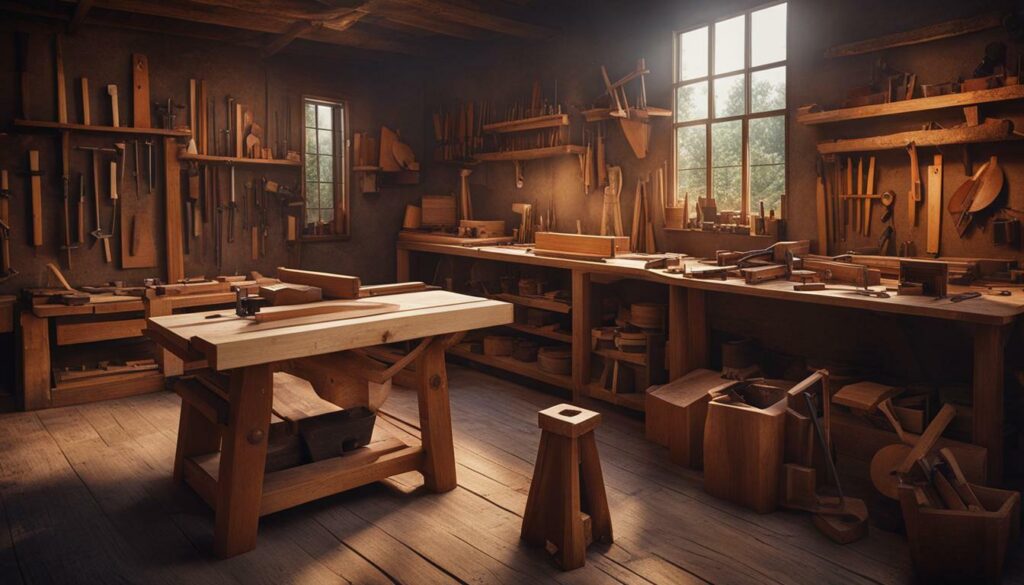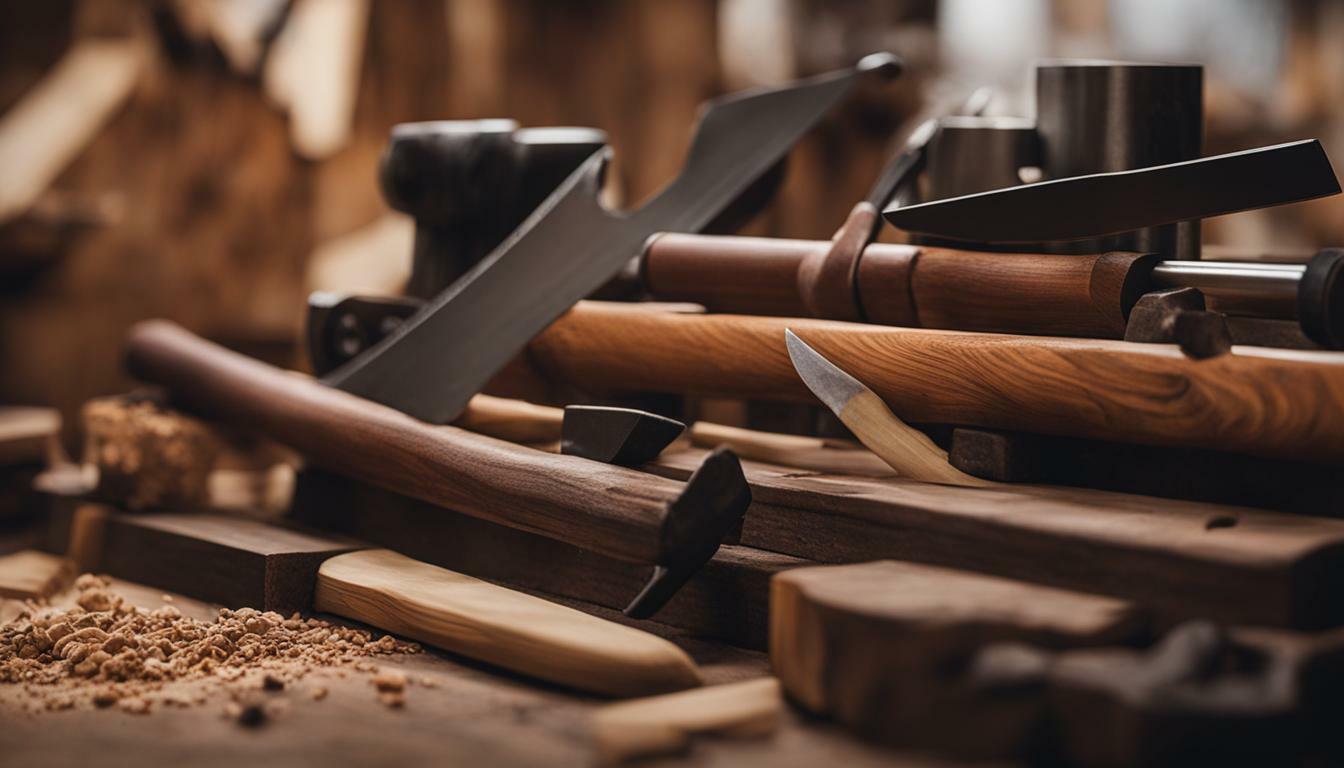Woodworking is a diverse craft that encompasses various types of woodworking techniques and styles. Whether you’re a beginner or an experienced woodworker, exploring the different types of woodworking can open up a world of creativity and craftsmanship. From wood carving to furniture making, there are countless ways to express your creativity through this timeless craft.
- Woodworking involves different techniques such as wood carving, woodturning, and pyrography.
- There are various styles of woodworking, including furniture making and intarsia.
- Different types of wood, such as softwoods and hardwoods, are used in woodworking projects.
- Woodworking can be pursued as a hobby or a profession.
- There are resources available to learn woodworking skills and techniques.
Woodworking Techniques: Exploring Different Methods
Woodworking encompasses a wide range of techniques that can be used to shape and transform wood in various ways. From wood carving to woodturning, pyrography to scroll sawing, and intarsia to marquetry, each technique offers unique characteristics and tools that allow you to unleash your creativity.
Wood carving is the art of shaping wood by carving away material using carving tools. It allows you to create intricate designs and sculptures, adding intricate details to your woodworking projects. Woodturning, on the other hand, involves using a lathe machine to shape the wood while it spins rapidly. This technique is commonly used to create bowls, vases, and even furniture legs.
If you’re interested in adding decorative elements to your woodworking projects, pyrography is a technique you’ll love. Pyrography utilizes a heated tool to burn designs onto the surface of the wood, allowing you to create beautiful patterns and textures. Scroll sawing, on the other hand, involves using a specialized saw to cut intricate patterns and shapes in wood, giving your projects a delicate and ornate appearance.
Intarsia and marquetry are techniques that involve creating wood mosaics by using different types and colors of wood to create intricate patterns and images. These techniques are commonly used in furniture making and art pieces, allowing you to showcase your artistic skills and create stunning visual effects.
| Technique | Description |
|---|---|
| Wood Carving | The art of shaping wood by carving away material using carving tools. |
| Woodturning | Using a lathe machine to shape the wood while it spins rapidly. |
| Pyrography | Burning designs onto wood using a heated tool. |
| Scroll Sawing | Cutting intricate patterns and shapes in wood using a specialized saw. |
| Intarsia and Marquetry | Creating wood mosaics by using different types and colors of wood to create intricate patterns and images. |
By exploring and mastering these different woodworking techniques, you can enhance your woodworking skills and create beautiful, unique projects that showcase your creativity and craftsmanship.

Remember, woodworking is a journey of continuous learning and improvement. As you delve deeper into the world of woodworking, you’ll discover new techniques and methods that will further expand your skillset. Whether you prefer the precision of woodturning or the artistic expression of pyrography, there’s a woodworking technique out there that will captivate and inspire you.
Woodworking Styles: Unleashing Your Creative Side
Woodworking offers a multitude of styles, each with its own unique aesthetic and creative approach. Whether you prefer the timeless elegance of traditional furniture making or the intricate artistry of intarsia and marquetry, there is a woodworking style to suit every creative vision. Let’s explore some of the most popular woodworking styles and the craftsmanship they encompass.
One beloved woodworking style is furniture making, where woodworkers craft functional pieces that are both beautiful and practical. From classic designs to contemporary creations, furniture making allows you to express your personal style while honing your woodworking skills. Whether you’re crafting a stunning dining table or a cozy bookshelf, furniture making provides endless opportunities to showcase your craftsmanship.
For those seeking a more artistic expression of woodworking, intarsia and marquetry are captivating styles to explore. These intricate techniques involve the creation of wood mosaics, where different types of wood are carefully cut and fitted together to form stunning patterns and designs. The level of detail and precision required in intarsia and marquetry make them truly awe-inspiring woodworking styles.
The Beauty of Intarsia and Marquetry: Where Wood Meets Art

Woodworking is not limited to furniture and decorative objects alone. It extends to the realm of boat building, where skilled craftsmen create seaworthy vessels using their woodworking expertise. Whether it’s a small sailboat or a majestic yacht, boat building combines the beauty of woodworking with the functionality of a floating masterpiece.
Regardless of the woodworking style you choose to pursue, it is important to select the right type of wood to bring your vision to life. Various types of wood, such as softwoods and hardwoods, offer different qualities and characteristics that can enhance your woodworking projects. Softwoods like pine and cedar are commonly used for their versatility, while hardwoods like oak and walnut are prized for their durability and rich grain patterns.
Woodworking is a versatile and rewarding craft that allows you to unleash your creativity and showcase your woodworking skills. With a multitude of styles, techniques, and wood types to explore, the possibilities are endless. So, pick up your tools, select your preferred woodworking style, and let your creativity flourish in the world of woodworking.
Exploring Wood Types: From Softwoods to Hardwoods
Woodworking projects can be crafted using different types of wood, each with its own distinct characteristics and suitability for specific projects. Understanding the different types of wood is essential for selecting the right material for your woodworking endeavors. Let’s explore the various wood types commonly used in woodworking.
Softwoods
Softwoods, such as pine, cedar, fir, spruce, and redwood, are often favored for their affordability, lightweight nature, and ease of working. They are commonly used in projects that require structural stability, such as building furniture frames, outdoor decking, or constructing basic structures. Softwoods also have a unique appearance, with natural knots and patterns that can add rustic charm to your woodworking creations. However, they may not be as durable or resistant to wear and tear compared to hardwoods.
Hardwoods
Hardwoods, including oak, maple, cherry, mahogany, and walnut, are prized for their strength, durability, and rich color variations. They are ideal for projects that demand resilience and longevity, such as high-quality furniture, cabinetry, and intricate woodcraft. Hardwoods are often more expensive than softwoods due to their scarcity and desirable characteristics. They can be more challenging to work with due to their density, but the end results are often stunning, showcasing the natural beauty and elegance of the wood.
Engineered Wood
In addition to natural wood species, engineered wood products like plywood, oriented strand board (OSB), medium density fiberboard (MDF), and composite board are commonly used in woodworking. These materials are composed of wood fibers or particles bonded together with adhesives, resulting in strong and versatile products. Engineered wood offers stability, resistance to warping or shrinking, and a uniform surface for painting or staining. They are suitable for a variety of projects, from cabinetry to shelving, where consistent quality and dimensional accuracy are desired.
When planning your woodworking projects, consider the characteristics and features of each wood type to determine the most suitable material. Take into account factors such as durability, appearance, workability, and budget. By utilizing the right wood for your projects, you can achieve beautiful and long-lasting creations that showcase your woodworking skills and craftsmanship.
| Wood Type | Characteristics | Suitability |
|---|---|---|
| Softwoods | Affordable, lightweight, natural knots and patterns | Furniture frames, outdoor decking, basic structures |
| Hardwoods | Strong, durable, rich color variations | Furniture, cabinetry, intricate woodcraft |
| Engineered Wood | Stable, resistant to warping or shrinking, uniform surface | Cabinetry, shelving, consistent quality and accuracy |

Woodworking can be pursued as both a rewarding hobby and a fulfilling profession. Whether you’re looking to explore your creative side or develop a skillset for a potential career, woodworking offers endless possibilities. From small projects like crafting intricate boxes to larger endeavors such as building furniture or even constructing boats, woodworking allows you to unleash your imagination and create something beautiful with your own hands.
For many, woodworking starts as a hobby—a way to relax, unwind, and escape the stresses of daily life. It provides a sense of satisfaction and fulfillment as you transform a raw piece of wood into a functional or decorative object. As a hobbyist woodworker, you have the freedom to experiment with various techniques and styles, honing your skills and discovering new ways to express your creativity.
However, woodworking can also be a fulfilling profession for those who have a passion for craftsmanship. Whether you’re interested in furniture making, cabinetry, or architectural woodworking, pursuing a career in woodworking allows you to turn your passion into a viable source of income. With the right combination of skill, creativity, and dedication, you can establish yourself as a professional woodworker and create unique pieces that are truly works of art.

If you’re interested in learning woodworking skills and techniques, there are numerous resources available to help you get started. Online tutorials and instructional videos offer a convenient way to learn at your own pace, while woodworking classes and workshops provide hands-on training and guidance from experienced craftsmen. Additionally, woodworking books and magazines can serve as valuable references, providing step-by-step instructions and inspiration for your projects.
Remember, whether you choose to pursue woodworking as a hobby or a profession, the key is to start small and gradually build your skills and knowledge. Don’t be afraid to make mistakes and learn from them. With practice and perseverance, you’ll be amazed at what you can accomplish in the world of woodworking.
| Woodworking Hobby | Woodworking Profession |
|---|---|
| Relaxation and stress relief | Potential source of income |
| Creative expression | Opportunity for growth and advancement |
| Flexible schedule | Collaboration with clients or design professionals |
| Experimentation and learning | Creating unique, custom pieces |
Whether you choose to pursue woodworking as a hobby or a profession, the journey will be filled with creativity, satisfaction, and continuous learning. So, pick up your tools, unleash your passion, and let woodworking become an integral part of your life.
Learning Woodworking: Growing Your Skillset
Learning woodworking involves accessing various resources that can help you develop your skills and techniques. Whether you’re a beginner looking to get started or an experienced woodworker wanting to refine your craft, there are plenty of options available.
One valuable resource for learning woodworking is online tutorials. These provide step-by-step instructions and visual demonstrations, allowing you to learn at your own pace from the comfort of your own home. Websites and video platforms offer a wide range of tutorials on different woodworking techniques, projects, and tool usage. By following these tutorials, you can gain valuable insights and build confidence in your woodworking abilities.
Another option to enhance your woodworking skills is by attending woodworking classes. These classes offer hands-on learning experiences and expert guidance from experienced instructors. Whether you prefer in-person classes or online workshops, you’ll have the opportunity to learn alongside fellow woodworkers, ask questions, and receive personalized feedback. Woodworking classes cover a variety of topics, from basic woodworking techniques to advanced joinery and furniture making.
Books and magazines are also valuable resources for expanding your knowledge in woodworking. They provide in-depth information on different woodworking styles, techniques, and projects. You can find a wide range of woodworking publications that cater to all skill levels, from beginners to seasoned professionals. These resources often include detailed illustrations, step-by-step instructions, and valuable tips and tricks from experts in the field.
To further enhance your woodworking skills, consider joining woodworking communities and forums. These platforms allow you to connect with other woodworkers, share ideas, ask for advice, and seek inspiration. You can learn from the experiences of others, gain new perspectives, and participate in discussions about woodworking techniques, tool recommendations, and project ideas.

| Resource | Description |
|---|---|
| Online Tutorials | Step-by-step instructions and visual demonstrations available on websites and video platforms. |
| Woodworking Classes | Hands-on learning experiences with expert guidance from experienced instructors. |
| Books and Magazines | In-depth information on different woodworking styles, techniques, and projects. |
| Woodworking Communities and Forums | Platforms to connect with other woodworkers, share ideas, and seek advice. |
“Woodworking is a never-ending journey of learning and growth. By exploring these resources and immersing yourself in the wonderful world of woodworking, you can unlock your creativity and refine your skills. Remember, practice makes progress, so embrace the process and enjoy the satisfaction of creating beautiful pieces with your own hands.”
The Beauty of Woodworking Projects
Woodworking projects span a wide spectrum, ranging from small decorative items to large-scale structures. Whether you’re a seasoned woodworker or just starting out, there is a project for everyone to explore their creativity and craftsmanship. From intricately carved wooden figurines to beautifully crafted furniture pieces, the possibilities are endless.
One of the joys of woodworking is the ability to work with different types of wood. Each type has its own unique characteristics and lends itself to specific projects. Softwoods like pine and cedar are often used for carving delicate designs, while hardwoods such as oak and walnut are prized for their strength and durability, making them ideal for furniture making. Engineered wood, like plywood, offers versatility and stability, making it a popular choice for constructing cabinets and shelves.
Woodworking also encompasses a variety of techniques. Wood carving involves shaping wood using chisels and gouges to create intricate designs. Woodturning employs a lathe to shape wood into cylindrical objects like bowls and candlesticks. Pyrography, or wood burning, allows for intricate designs to be etched onto wooden surfaces. Intarsia and marquetry involve the art of piecing together different wood veneers to create stunning mosaics.
| Woodworking Technique | Description |
|---|---|
| Wood Carving | Shaping and sculpting wood using specialized carving tools. |
| Woodturning | Creating cylindrical objects by rotating wood on a lathe while shaping it with various tools. |
| Pyrography | Burning designs into wood using a heated tool. |
| Scroll Sawing | Using a specialized saw to create intricate cuts and patterns in wood. |
| Intarsia and Marquetry | Creating intricate designs by piecing together different wood veneers. |
Whether you’re interested in crafting small projects like wooden jewelry boxes or taking on larger endeavors like building your own boat, woodworking offers a world of possibilities. With the right tools, techniques, and a bit of creativity, you can bring your woodworking projects to life and create beautiful objects that will be cherished for years to come.

The Importance of Woodworking Tools
Woodworking tools play a crucial role in achieving precision and quality in woodworking projects. Whether you’re a beginner or an experienced woodworker, having the right tools is essential for bringing your creative vision to life. From shaping and carving wood to joining and finishing pieces, each tool serves a specific purpose and contributes to the overall success of your project.
One of the most fundamental woodworking tools is the chisel. With its sharp blade and sturdy handle, the chisel allows you to carve intricate details and shape wood to perfection. Whether you’re working on a small-scale project like a jewelry box or tackling a larger piece of furniture, a set of high-quality chisels is a must-have in your workshop.
Another indispensable tool is the table saw. This powerful tool enables you to make accurate cuts and rip boards to size with ease. Whether you’re creating joinery or cutting larger panels, a table saw provides stability and precision, ensuring that your pieces fit together seamlessly.
When it comes to joining pieces of wood, a woodworking clamp is essential. A clamp helps to hold your workpiece securely in place, allowing you to apply pressure while gluing or assembling. With a variety of clamp types available, including bar clamps, pipe clamps, and spring clamps, you can choose the right tool for the job and achieve strong, sturdy joints.
| Tool | Purpose |
|---|---|
| Chisel | Carving and shaping wood |
| Table Saw | Accurate cutting and ripping boards |
| Woodworking Clamp | Holding workpieces securely |
Having the right tools is essential for bringing your creative vision to life.
In addition, power tools like the router and the orbital sander can greatly enhance your woodworking capabilities. The router enables you to create decorative edges, cut joinery, and hollow out areas, while the orbital sander smooths surfaces and prepares wood for finishing. These power tools save you time and effort, allowing you to achieve professional-quality results.
Remember, investing in high-quality tools is a worthwhile long-term investment. Not only do they contribute to the success of your current projects, but they also provide reliability and durability for future endeavors. So, equip yourself with the essential woodworking tools and unlock your potential as a skilled craftsman.

Safety is paramount in woodworking, and following proper precautions is essential for a safe and enjoyable woodworking experience. Whether you’re a beginner or a seasoned woodworker, it’s crucial to prioritize safety throughout your woodworking journey.
One of the first precautions to take is wearing the appropriate personal protective equipment (PPE). This includes safety glasses or goggles to protect your eyes from flying debris, a dust mask to prevent inhalation of wood dust, and ear protection to safeguard against loud noises from power tools.
Additionally, it’s important to maintain a clean and organized workspace. Keep your work area free from clutter and ensure that all tools and materials are properly stored when not in use. This not only promotes efficiency but also minimizes the risk of accidents caused by tripping or falling objects.
Another vital safety measure is familiarizing yourself with the proper operation and maintenance of woodworking tools. Always read the manufacturer’s instructions and follow safety guidelines when using power tools. Keep blades sharp, use appropriate cutting techniques, and never force a tool beyond its capabilities. Regularly inspect your tools for wear or damage and replace any worn or damaged parts immediately.
By taking these precautions and adhering to proper safety practices, you can enjoy the art of woodworking while minimizing the risk of injuries. Remember, safety should always be the cornerstone of every woodworking project.

| Precaution | Description |
|---|---|
| Wear PPE | Protective eyewear, dust mask, and ear protection |
| Maintain a Clean Workspace | Ensure a clutter-free and organized work area |
| Familiarize Yourself with Tools | Read instructions, follow safety guidelines, and inspect tools regularly |
Quotes:
“Safety is not an accident. It’s a choice.”
Remember, accidents can happen even to the most experienced woodworkers. Always prioritize your safety and take the necessary precautions to prevent injuries. Woodworking is an exciting and fulfilling craft, and by following safety protocols, you can enjoy it for years to come.
Conclusion
With its variety of techniques, styles, and projects, woodworking offers a rich and rewarding craft for individuals of all skill levels. Whether you’re a beginner or an experienced woodworker, exploring the different types of woodworking can open up a world of creativity and craftsmanship.
Woodworking encompasses various types of woodworking, including wood carving, woodturning, pyrography (wood burning), scroll sawing, intarsia and marquetry (wood mosaics), furniture making, boxes, and boat building. Each type of woodworking involves different techniques and tools, and can be used to create a wide range of objects and structures.
Woodworking also utilizes different types of wood, such as softwoods (pine, cedar, fir, spruce, redwood), hardwoods (oak, maple, cherry, mahogany, walnut), and engineered wood (plywood, oriented strand board, medium density fiber board, composite board). Each type of wood has its own characteristics and is suitable for different projects.
Whether you choose to pursue woodworking as a hobby or a profession, there are various resources available to learn woodworking skills and techniques. From online tutorials to woodworking classes, you can enhance your skillset and unleash your creativity in the world of woodworking.
So, embrace the beauty of woodworking and let your skills flourish. Start your woodworking journey today and discover the endless possibilities that this timeless craft has to offer.
What Are the Basic Hand Tools Needed for Different Types of Woodworking?
When it comes to woodworking, having the right basic woodworking hand tools is crucial. Whether you are a beginner or an experienced woodworker, a few essential tools are a must. These include a claw hammer for driving and removing nails, a chisel for shaping and carving, a hand saw for cutting wood, a tape measure for precise measurements, and a set of screwdrivers for assembling and disassembling various components. Investing in these tools will enable you to tackle different woodworking projects efficiently.
FAQ
Q: Are there different types of woodworking?
A: Yes, woodworking encompasses various types such as wood carving, woodturning, pyrography, scroll sawing, intarsia and marquetry, furniture making, boxes, and boat building.
Q: What are the different woodworking techniques?
A: Woodworking techniques include wood carving, woodturning, pyrography, scroll sawing, intarsia and marquetry.
Q: What are the different woodworking styles?
A: Woodworking styles include traditional furniture making, intarsia and marquetry, and various creative possibilities.
Q: What types of wood are used in woodworking projects?
A: Woodworking uses softwoods, hardwoods, and engineered wood such as plywood and medium density fiber board.
Q: Can woodworking be pursued as a hobby or profession?
A: Yes, woodworking can be pursued both as a fulfilling hobby and a professional career.
Q: Where can I learn woodworking skills and techniques?
A: There are various resources available, including online tutorials and woodworking classes, to learn woodworking skills and techniques.
Q: What kind of projects can be created through woodworking?
A: Woodworking projects can range from furniture making to crafting boxes and even building boats.
Q: What are the essential woodworking tools?
A: Essential woodworking tools include saws, chisels, planes, drills, and measuring tools.
Q: What safety precautions should I take in woodworking?
A: It’s important to follow safety precautions such as wearing protective gear, using proper handling techniques, and keeping the workspace clean and organized.
Q: How can woodworking enhance my creativity and craftsmanship?
A: Woodworking offers a diverse range of techniques, styles, and projects, allowing you to explore your creativity and develop your skills as a craftsman.

